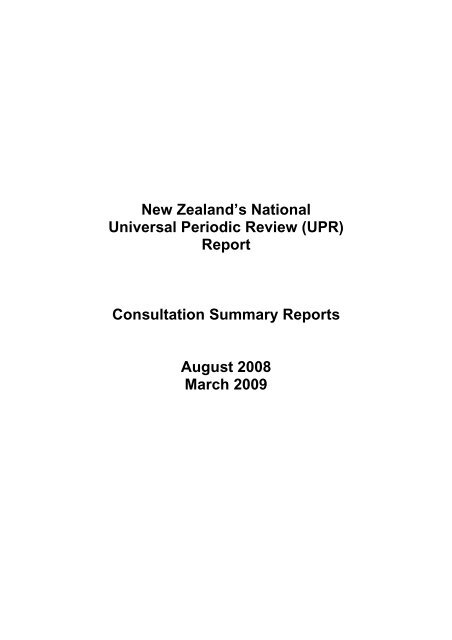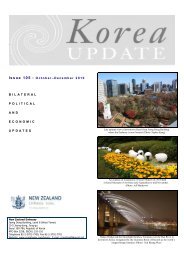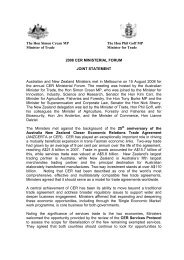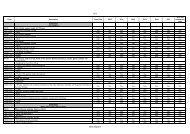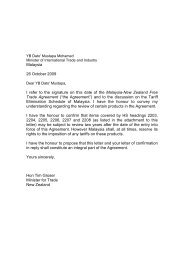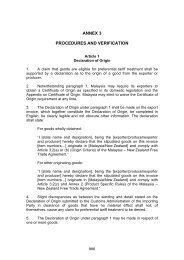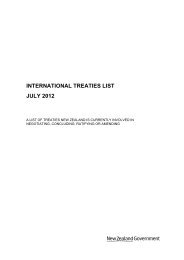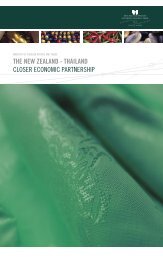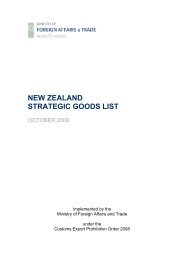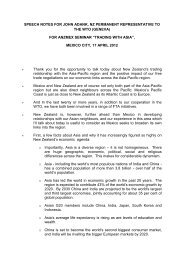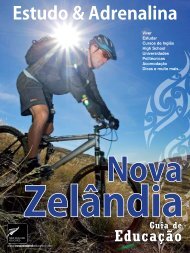New Zealand's National Universal Periodic Review (UPR) Report ...
New Zealand's National Universal Periodic Review (UPR) Report ...
New Zealand's National Universal Periodic Review (UPR) Report ...
- No tags were found...
Create successful ePaper yourself
Turn your PDF publications into a flip-book with our unique Google optimized e-Paper software.
<strong>New</strong> Zealand’s <strong>National</strong><strong>Universal</strong> <strong>Periodic</strong> <strong>Review</strong> (<strong>UPR</strong>)<strong>Report</strong>Consultation Summary <strong>Report</strong>sAugust 2008March 2009
Meeting of civil society organisations to discuss the <strong>Universal</strong> <strong>Periodic</strong> <strong>Review</strong> of<strong>New</strong> Zealand by the United Nations Human Rights Council, Christchurch, 4 August2008.Consultations were held by the Ministry of Foreign Affairs and Trade and the HumanRights Commission in Christchurch on Monday 4 th August 2008. Stakeholders met todiscuss <strong>New</strong> Zealand’s <strong>Universal</strong> <strong>Periodic</strong> <strong>Review</strong> – the new human rights reportingmechanism for the UN Human Rights Council. A total of 20 participants attended theroundtable from the following civil society organisations: City Mission; DPA; MāoriWomen’s Welfare League; Community Law Canterbury; Canterbury United NationsAssociation; NZ Prostitutes Collective; Lesbian and Gay community; AGENDER(Transgender); Howard League for Penal Reform; Network Waitangi Otautahi; MentalHealth Education and Resource Centre Trust; Canterbury Men’s Centre; ChristchurchCommunity House; <strong>New</strong> Zealand EPMU/CTU Canterbury; Te Rūnanga o Ngāi Tahu;Prisoners Aid and Rehabilitation Society; Christchurch Resettlement ServicesApologies were received from Age Concern, the Tenants Protection Association, Councilfor Social Services and PEETO.The Deputy Director of the United Nations, Human Rights and Commonwealth Division ofthe Ministry of Foreign Affairs and Trade, Michael McBryde, outlined the <strong>UPR</strong> process andhow civil society organisations can participate in <strong>New</strong> Zealand’s <strong>UPR</strong> examination. Headvised that their views would help inform <strong>New</strong> Zealand’s national <strong>UPR</strong> report and thatkey stakeholders, including NGOs and the Human Rights Commission are able to maketheir own individual submissions direct to the Office for the High Commissioner for HumanRights in Geneva. Accredited NGOs and the Human Rights Commission can attend <strong>New</strong>Zealand’s review in May 2009 in Geneva and can make statements during the adoption ofthe final <strong>UPR</strong> outcome for <strong>New</strong> Zealand at the Council. He advised groups to keep an eyeon the website of the Office of the High Commissioner for Human Rights (www.ohchr.org )for the deadline for submission of their own reports.Race Relations Commissioner Joris de Bres outlined the key issues identified in theCommission’s 2004 review of human rights in <strong>New</strong> Zealand and progress in achieving thepriority actions in the <strong>New</strong> Zealand Action Plan for Human Rights. He said the conclusionsof the status report provided a baseline for the <strong>UPR</strong> which he hoped would be useful topeople wanting to make submissions. While the Commission had not yet completed itsreview, major human rights challenges identified included violence against women andchildren, the high levels of imprisonment, social and economic inequality (particularly as itaffected Maori and Pacific peoples), Crown-Maori relationships, and poverty.Those present then identified both achievements and challenges. The achievementsincluded the Prostitution Law Reform Act, the PATHS Programme providing access tohealth solutions for sickness beneficiaries, the ratification of the Optional Protocol to theConvention against Torture (OPCAT), and the Transgender Inquiry report. Some of thesein turn presented new challenges in terms of implementation or resourcing the changes.Challenges identified can be summed up into seven areas as follows:1. The persistence of discrimination and barriers (including in relation to gender (bothwomen and girls and men and boys), mental health, disability, lesbian and gaypeople, transgender, and migrants2. The criminal justice system and its treatment of Maori in particular, and the highlevel of imprisonment2
3. Violence and abuse, including against women and children, the elderly and disabledpeople, and bullying in schools4. The human rights framework, including the need for constitutional entrenchment ofhuman rights and the Treaty, curbs on the power of the executive, a process toensure follow up of recommendations and declarations from United Nations and<strong>New</strong> Zealand human rights bodies, providing for responsibilities as well as rights,and balancing the rights of different groups of rights holders (horizontal applicationof human rights)5. The continued experience of poverty by a significant number of <strong>New</strong> Zealanders,and the disproportionate effect on Maori and Pacific peoples, children and disabledpeople6. Immigration, including the situation of migrant workers, policy on familyreunification, refugees, support for settlement and integration7. Resources to support civil society as an important component of a human rightsframework, including both NGO’s and community based groups (CBO’s)It was further noted that this meeting should not be seen as satisfying the requirement forconsultation with civil society but rather as a beginning of that process. Those presentwould also like the opportunity to comment on the government’s draft report before thedeadline for their own submissions to the Office of the High Commissioner for HumanRights. Interest was also expressed in seeing the government’s response to UnitedNations treaty bodies and special procedures.The Ministry of Foreign Affairs thanked those present for their contributions and noted thatthe nature of further consultation had yet to be determined by government.3
4<strong>New</strong> Zealand Human Rights ConsultationAuckland, 13 August 2008Present: Peter Jenkins, Sensible Sentencing Trust; Parvez Akbar, Employers andManufacturers Association; Lesley Belcham, Outline <strong>New</strong> Zealand; Felicity Lamm, DanaeAnderson, Auckland University of Technology; Beverley Turner, Pacific Women’s Watch;Jesse Colquhoun, Auckland City Council; Cathy Parker, Genderbridge; Juanita Muslua,Shakti Asian Women’s Centre; Rodney Mapleston, Psychiatric Survivors; Penny Bright,Water Pressure Group; Richard Northey, Auckland District Council of Social Services;Rina Tagore, Manukau City Council; Janferie Bryce-Chapman, Age Concern North Shore;Rachael Le Mesinner, <strong>New</strong> Zealand AIDS Foundation; Farida Sultana, WAV; JoanMacdonald, WILPF; Shila Nair, Shakti Community Council; Crystal Shrestha, ShaktiCommunity Council; Philomena Lobo Shakti Women’s Safe House; Kate Waterworth,Action for Children and Youth Aotearoa; Bharat Jamnadas, Asia Down Under; DrRasalingam, Ethnic Voice; Antony Vallyon, UNANZ; Suzanne Mahon, Auckland InterfaithCouncil; Judi Clements, Mental Health Foundation; Thomas Hamilton, Genderbridge;Gidion McCusker Dixon, Human Rights Council.Apologies: Office of Advancement of Women for the Baha'i Community of <strong>New</strong> Zealand,the Children's Issues Centre, Literacy Aotearoa and the Council of Civil Liberties.Consultations were held by the Ministry of Foreign Affairs and Trade and the HumanRights Commission in Auckland on Wednesday 13 th August 2008. Stakeholders met todiscuss <strong>New</strong> Zealand’s <strong>Universal</strong> <strong>Periodic</strong> <strong>Review</strong> and the mid-term review of the <strong>New</strong>Zealand Action Plan for Human Rights 2005-2010.The Director of the United Nations, Human Rights and Commonwealth Division of theMinistry of Foreign Affairs and Trade, Joan Mosley, outlined the <strong>UPR</strong> process and howcivil society organisations can participate in <strong>New</strong> Zealand’s <strong>UPR</strong> examination. Sheadvised that their views would help inform <strong>New</strong> Zealand’s national <strong>UPR</strong> report and thatkey stakeholders, including NGOs and the Human Rights Commission, are able to maketheir own individual submissions direct to the Office for the High Commissioner for HumanRights in Geneva. Participants were advised to keep an eye on the website of the Officeof the High Commissioner for Human Rights (www.ohchr.org ) for the deadline forsubmission of their own reports, which could be in the next few months. In terms ofconsultation on the <strong>New</strong> Zealand’s draft national <strong>UPR</strong> report, participants were told thatthis would be subject to further Ministerial consideration.Chief Commissioner Rosslyn Noonan outlined the key issues identified in theCommission’s 2004 review of human rights in <strong>New</strong> Zealand and progress in achieving thepriority actions in the <strong>New</strong> Zealand Action Plan for Human Rights. She said that the initialassessment concluded that while some notable advances have been over the last fewyears, there were still some major human rights challenges that have to be addressed andareas where we can do better. <strong>New</strong> Zealand’s <strong>UPR</strong> examination represented a realopportunity to get some of these issues addressed.Those present then identified, challenges, progress over the last few years and priorityactions for the future. Challenges identified (in no particular order) included:• Recognising access to water as a human rights issue• An adequate standard of living for all <strong>New</strong> Zealanders• Independent audit of corruption and conduct of judiciary
• Child poverty, including challenging discrimination against children whose parentsare beneficiaries• Asylum seekers access to services including accredited interpreters and ending thepractice of imprisonment with convicted criminals• Improved enforcement of labour standards for health and safety• Establishing human rights standards for child labour• Ending child abuse• Elderly abuse and protection in institutional care• Domestic violence, including violence against people with experience of mentalillness• Lack of migrant women in leadership roles• Lack of culturally appropriate foster homes for the children of ethnic minorities• <strong>New</strong> Zealand’s position on the Declaration of the Rights of Indigenous Peoples• Institutional racism and poverty• The Treaty of Waitangi formally incorporated into <strong>New</strong> Zealand’s constitutionalarrangements• Involuntary hospitalisation of mental health patients for excessive periods of timeand inadequate funding levels for community care• Rights of immigrants• Combating covert discrimination in employment recruitment• Improving the position of sexual minorities• Affirmative action for minorities• High imprisonment rates, especially for Maori, and lack of rehabilitation services• Exclusion of children from school and discrimination concerning disabled children’saccess to education services.• Improving the rights of children in the Family Court and in the Youth Justice system• Discrimination against migrants• Rural issues e.g. equal access to health services.• Cultural “rights” and practices versus human rights e.g. dowries and polygamyParticipants agreed that <strong>New</strong> Zealand’s human rights situation has improved in a numberof areas including:• Disabled persons rights including <strong>New</strong> Zealand Sign Language becoming an officiallanguage and <strong>New</strong> Zealand signing the Convention on the Rights of Persons withDisabilities);• The treatment of asylum seekers• Establishing minimum workplace health and safety standards• Establishing the Positive Ageing Strategy and monitoring results• The HRC Inquiry into Discrimination Experienced by Transgender People• Some progress in implementing the mental health blue print• Employers are more aware of human rights issues• Positive shift in some societal attitudes e.g. the Like Minds Like Mine campaign• Prostitution Law Reform Act; and Civil Union Act.It was noted that there was a need to access non-government progress to get a betterpicture on <strong>New</strong> Zealand’s human rights situationA number of priority actions were also identified including:• the differentiation in opportunities for children from different backgrounds• interpreting body for languages5
6• mainstreaming the rights of women• developing a charter for mental health• improving access for the transgender community to health services; and• reviewing employment law to look at discrimination issues.The Human Rights Commission and the Ministry of Foreign Affairs and Trade thankedthose present for their contributions.
7<strong>New</strong> Zealand Human Rights Consultation RoundtableWellington Monday 18 August 2008Present: Barbara Lambourn, UNICEF, <strong>New</strong> Zealand; Catherine Healy, <strong>New</strong> ZealandProstitutes Collective; Calum Bennachie, <strong>New</strong> Zealand Prostitutes Collective; CedSimpson, Human Rights in Education; Charles Waldegrave, Family Centre; Chris Petersand Jolene Molloy, Hearing Association Inc; Claire Szabo, ESOL Home Tutors; DianaCrossan, Retirement Commissioner; Eileen Brown, NZCTU; Graham Howell, Wellington’sPeople’s Centre; John Parrott, Wellington City Council, Mary Wareham, Human RightsWatch; Mereana Ruri, Office of the Children’s Commissioner; Mike Reid, LGNZ; NicholasGreen, Business <strong>New</strong> Zealand; Paul Browne, Transparency International; Richard Archer,Pax Christi; Robin Halliday and John Morgan, UNA, Wellington; Rose Dew, Council forInternational Development; Ruth Jones, CCS Disability Action; Susan Elliot, NZEI; TimO'Donovan, Development Resource Centre; Tony Wilton, EPMU; Edwina Hughes, PeaceMovement Aotearoa.Human rights consultations were held by the Ministry of Foreign Affairs and Trade and theHuman Rights Commission in Wellington on Monday 18 th August 2008. Ministry ofJustice officials also attended the meeting. Stakeholders met to discuss <strong>New</strong> Zealand’s<strong>Universal</strong> <strong>Periodic</strong> <strong>Review</strong> and the mid-term review of the <strong>New</strong> Zealand Action Plan forHuman Rights 2005-2010.The Deputy Director of the United Nations, Human Rights and Commonwealth Division ofthe Ministry of Foreign Affairs and Trade, Michael McBryde, outlined the <strong>UPR</strong> process andhow civil society organisations can participate in <strong>New</strong> Zealand’s <strong>UPR</strong> examination. Headvised that their views would help inform <strong>New</strong> Zealand’s national <strong>UPR</strong> report and thatkey stakeholders, including NGOs and the Human Rights Commission, are able to maketheir own individual submissions direct to the Office for the High Commissioner for HumanRights in Geneva. Participants were advised that the deadline for submission of their ownreports has just been announced by OHCHR as Monday 10 November 2008. In terms ofconsultation on the <strong>New</strong> Zealand’s draft national <strong>UPR</strong> report, participants were told thatthis would be subject to further Ministerial consideration.Chief Commissioner Rosslyn Noonan outlined the key issues identified in theCommission’s 2004 review of human rights in <strong>New</strong> Zealand and progress in achieving thepriority actions in the <strong>New</strong> Zealand Action Plan for Human Rights. She said that the initialassessment concluded that while some notable advances have been over the last fewyears, there were still some major human rights challenges that have to be addressed andareas where we can do better. <strong>New</strong> Zealand’s <strong>UPR</strong> examination represented a realopportunity to get some of these issues addressed.Those present then identified, challenges, progress over the last few years and priorityactions for the future. Challenges identified (in no particular order) included:• Immigration policy changing quickly –support mechanisms not keeping pace.• Fragility of employee rights – ratification of ILO Conventions – weak compliance ofILO Convention.• Ratification and implementation of Convention of the Rights of Persons withDisabilities.• Linking up of human rights between groups.• Income inequalities in the labour market.• Right to education for children of people studying here
• Bullying at schools – around sexuality.• Inadequate resources for mainstreaming children with disabilities in <strong>New</strong> Zealandclassrooms.• Pay and employment equity issues.• Impact of poverty/violence/abuse/neglect of children.• Lowering age of criminality.• Impact of those on the DPB returning to work early.• DRIP and the interface with the Treaty of Waitangi and other indigenous issues.• Poverty.• Affordable and accessibility to decent housing including home ownership.• Corruption and transparency issues – local body reporting – behaviour of <strong>New</strong>Zealand companies offshore.• Challenges for older workers.• Right to financial education – embedded in school curriculum/financial literacy.• Accessible buildings.• Education on civil and political rights in the curriculum.• Fair trade.• Lack of coordination across agencies on disability issues.• Employment disability issues.• <strong>New</strong> Zealand’s Government’s approach to Treaty of Waitangi and indigenousissues.• Constitutional fragility of protection of human rights.• Immigration and anti-terrorist legislation – breach of human rights.• Rights and conditions of people in detention.• Protection of migrant/part-time/student sex workers.• <strong>New</strong> Zealand’s overseas development assistance is addressing the key issues forsex workers in other countries.• Still challenges/discrimination against LGBT people.• Wide poverty gap – impact on children.• Restorative justice – victim and offender.• Maintaining human rights dialogue.• Human rights education in schools – <strong>New</strong> Zealand violates UNCROC (Art 42) –Ministry of Education action hampered by self-regulating schools.• Improving public access to human rights information – understanding of humanrights issues in the community.• Prisoner support mechanisms inadequate.• Disabled accessibility – infrastructure and education.• Senior citizens – care, poverty, support –• Restoration of benefit levels – abatement rates – universalisation of Working forFamilies – ethnic disparities – Maori and Pacific Islanders.• Health – mortality/morbidity - mental health issues.• <strong>New</strong> Zealand’s position on the Optional Protocol to ICESCR.• LGBT rights - UN rollback.• Political and civil rights education.• Employment disability.• Local government accountability.• Older workers’ rights.• Rights and conditions of people in detention (international).Participants agreed that <strong>New</strong> Zealand’s human rights situation has improved in a numberof areas including:8
• Decent work on the agenda.• Working for Families.• Income related state housing.• Access to primary health care.• Social report.• Taskforce on violence – funding of NGOs.• Cultural equity.• Wider recognition of disabilities issues eg sign language.• Signing and ratification (pending) of Convention on the Rights of Persons withDisabilities.• Prostitution Law Reform Act – puts human rights at heart of protection of sexworkers.• LGBT gains.• More public discussion on human rights – <strong>New</strong> Zealand Action Plan on HumanRights – 15,000 people consulted.• Changes to <strong>New</strong> Zealand curriculum on human rights education.• Establishment of NZ superannuation scheme• International human rights framework and monitoring and establishment of UNHuman Rights Council.• Improvement of women representation on public sector boards.A number of priority actions were also identified including:• <strong>Review</strong> of settlement.• Ratification of core ILO Conventions/better compliance – 138 and 183.• Rights of indigenous peoples.• No review of S59 legislation.• Sign the DRIP.• Benefits benchmarked to average wage as for national superannuation.• Preventative rather than punitive approach to justice.• Ratification of UN Convention Against Corruption.• <strong>Universal</strong> national superannuation (women’s status) – need to ensureachievements are not lost.• Right to financial education as part of school curriculum.• Remove Disparities in ACC rules - “natural disability”.• Developing fair trade agreements – make human rights a central component.• Reducing children.• Announcement of support for the DRIP at General Assembly Opening 2008.• Government to monitor human rights performance of NZ companies overseas.• <strong>New</strong> Zealand Government keeps up with developments in human rights law.• ILO/UN Migrant Workers Conventions on right of sex workers.• Restorative justice extension.• Improve education on human rights – as stipulated under Article 42.• Human rights framework in public policy setting/monitoring• Income inequalities – ethnicity.• Ratify Convention on the Rights of Persons with Disabilities.• End enforced treatment/detention.• Accessibility of information.• Inclusive education for all.• Business <strong>New</strong> Zealand position on ILO Conventions.• Youth justice.• Monitoring of cultural equity.9
• Develop fair trade agreements – impact statements and human rights implications.Some participants noted they would need more time to reflect internally on <strong>New</strong> Zealand’skey human rights challenges, progress and key priorities.The Human Rights Commission and the Ministry of Foreign Affairs and Trade thankedthose present for their contributions.10
Meeting of civil society organisations to receive feedback on <strong>New</strong> Zealand’s draftnational report under the <strong>Universal</strong> <strong>Periodic</strong> <strong>Review</strong> of the UN Human RightsCouncilWellington, 2 March 2009A Public Consultation meeting was held on Monday 2 March 2009 to allow Wellingtonbased stakeholders to discuss, and give feedback on <strong>New</strong> Zealand’s draft national reportunder the <strong>Universal</strong> <strong>Periodic</strong> <strong>Review</strong> (<strong>UPR</strong>) of the UN Human Rights Council. The meetingwas chaired by MOJ and MFAT.A total of 25 participants attended the meeting. The <strong>New</strong> Zealand Human RightsCommission (Susan Biggs, Bill Hamilton, Michael White) joined the following civil societyorganisations in attendance: Peace Movement Aotearoa (Edwina Hughes); UNICEF NZ(Barbara Lambourn); Amnesty International (Rebecca Emery, Patrick Holmes); HumanRights Foundation (Ced Simpson); Wellington Peace Foundation (Rod Alley); UNIFEM NZ(Alana Bowman, Rae Julian); Council for International Development (Pedram Pirnia, JustinKemp); Council of Trade Unions (Eileen Brown); Problem Gambling Foundation (KittyChan); Mental Health Foundation (Susan Cuthbert); NZ Council of Christian SocialServices (Stephen Olsen); IHC (Wendy Proffitt).Apologies were received from the Office of the Children’s Commissioner.Stuart Beresford (Ministry of Justice) outlined the purpose of the meeting: to inform on theprocess used for preparing <strong>New</strong> Zealand’s draft national report, and to seek directfeedback and views from participants on the draft report to inform <strong>New</strong> Zealand’s Ministersbefore submission of the final report. Michael McBryde (Deputy Director of the UnitedNations, Human Rights and Commonwealth Division of MFAT) gave a brief presentation ofthe <strong>UPR</strong> process. Richard Kay then outlined <strong>New</strong> Zealand’s process for drafting the report:the key themes, resources drawn on and challenges faced.Susan Biggs from the <strong>New</strong> Zealand Human Rights Commission (NZHRC) emphasised theimportance of these consultations, and encouraged those present to make the most of theopportunity to engage with the Government on its human rights priorities, and makesubmissions on the draft report.On a related issue, Stuart Beresford began discussions by recognising the difficultiesinvolved in engaging in the treaty body process generally. The Minister of Justice hasdirected MOJ to identify options to improve the process for preparing reports, and for howthe reports (and subsequent recommendations) are received by the government. Treatybody reporting should not simply be seen as a compliance issue, but about engaging onhuman rights issues, and on the recommendations.MOJ would welcome any comments people have on the process, and will be discussingthe matter with the NZHRC.11General comments on the report• Edwina Hughes: What period does the report cover?- The report is current up to December 2008; the start date for coverage is openended.
• Eileen Brown commented that events that have taken place since December 2008(both domestically and internationally) will impact on the human rights situation inNZ, and on the report. She noted that NGOs have no means of feeding in (inwriting) any concerns they have arising over this period. Edwina Hughes noted thatthe Working Group and the recommendations made will cover events right up untilthe date of hearing.• Rod Alley: International humanitarian law should be included in the report. Thiswould not just be for the benefit of improving the national report, but for also settingthe scope of the <strong>UPR</strong> generally, so that international humanitarian law is covered byStates where it is more of an issue than it is in NZ.• Ced Simpson agreed that a comprehensive treaty body reporting process wasnecessary, and highlighted that reports needed to be harmonised.• Edwina Hughes: Maori consultation: The number of hapu/iwi consulted wasinsufficient, as was the fact that initial consultations were held only in Christchurch,Wellington and Auckland. This was something that could be improved for next time.• Bill Hamilton: noted that there had been much criticism around the term“consultations”.Introduction• Rae Julian: The reference that “in 2000 all of the major constitutional positions wereheld by women” is somewhat disingenuous given that only one is held by a womantoday. It should be updated to reflect this.• Eileen Brown: Highlighting <strong>New</strong> Zealand’s ranking in the Global Gender Gap <strong>Report</strong>diminishes the objective of achieving gender equity in NZ.Section One: Methodology and Consultation Process• MFAT: This section will need to be updated to reflect the current consultationprocess agreed to by Cabinet.Section Two: Background of Country• Edwina Hughes:- 1) The reference in 2.1 to the separation of powers contradicts lattermention in the section of Parliamentary supremacy;- 2) the section fails to refer to the fact that there is no effective remedy forhuman rights violations in <strong>New</strong> Zealand’s legal structure;- 3) 2.4 should also list the instruments to which NZ is not a party (includingOptional Protocols) and any reservations it has made to human rightstreaties.• Bill Hamilton:- 1) 2.1: the relationship between the constitution and the Treaty of Waitangiis not clear in this section (reference of NZ’s “unwritten constitution” and theTreaty as a “founding document”);- 2) 2.1 (para 2) The role of tikanga Maori should be incorporated as it alsoinfluences the way in which our system operates (eg: it is included in somecourt judgments). This could be updated and linked to the Maori Party-<strong>National</strong> Party Agreement.- There is no date beside “English” when listing the official languages of NZ.• Ced Simpson: 2.6 para 3: need to clarify that the NZBORA only covers some civiland political rights, not economic, social and cultural rights, as the report currently12
implies. This is important given the question in NZ of the justiciability of economic,social and cultural rights.• Rebecca Emery: 2.7 para 2: include figure for how many <strong>New</strong> Zealanders havesought HRRT adjudication.Section Three: Promotion and Protection of Human Rights3.1: Treaty of Waitangi and the Rights of Indigenous People• Edwina Hughes:- 3.1 para 5: It is not enough to simply say ‘many Maori disagreed’ with theForeshore and Seabed Act. The report needs to say that there will be areview of the Act.- 3.1 para 8: this para should include what the government is going to doabout Maori concerns about the government’s position on the DRIP. Itshould also set out the government’s stance on the DRIP.- There is no mention of the government’s position on ILO169.• Bill Hamilton:- should be more than about redress and the settlement process, but aboutMaori and the Government moving forward together through other meansas well;- it gives the wrong impression to say that we have one of the largestindigenous populations- clarify the government position on the DRIP• Alana Bowman: Foreshore and Seabed Act discussion could include a footnote tothe contentions between government and Maori, and also on why the governmentwas unable to support the DRIP• Edwina Hughes: The section should also make clear that ICERD, the SpecialRapporteur and the Waitangi Tribunal have been critical of the NZ position.3.2 Gender• Susan Biggs/Rae Julian: several of the recommendations on pay equity have beenfrozen, and working parties are being scrapped. This section needs to be updated.• Rae Julian:- again need to make clear that women do not currently hold all the seniorconstitutional positions;- no mention of the CPAG action in relation to Working for Families, and thatit was beneficiaries who didn’t get the assistance.• Alana Bowman: there is a lack of discussion on women’s health, especially aroundthe situation of women and childbirth, and the effects of ACC exclusion of disease.• Eileen Brown:- First sentence: unsure if we can say NZ has always given priority to theadvancement of the rights of women. More accurate to say we have a‘strong history’ in this area;- The various references to pay equity need to be grouped together- While we rank highly comparatively, the report should recognise that thegender pay gap has been difficult to change. The section also needs toupdated in light of the decision to discontinue pay investigation – animportant component of adjusting for pay equity.- CEDAW Committee has also noted NZ is not meeting its obligations on payequity, and given a pay gap of 12% (and an even wider gap if comparing13
overall lifetime earnings and labour market involvement), then the absenceof the CEDAW recommendations is derelict.• Alana Bowman:- sexual health is not mentioned, nor is the existence of random femicide(the large number of homicides that result from women being abducted);- women’s declining position in trades should also be included given thecurrent economic climate3.3 Children and Young People• Barbara Lambourn:- <strong>Report</strong> should note that the Committee on the Rights of the Child has twicerecommended the removal of NZ’s reservations to UNCROC, but that thegovernment has failed to do so;- The Agenda for Children, while a worthy initiative, is no longer used toguide policy makers. There is no unit within any government agency topromote, coordinate, implement or monitor how the document’s principlesare being applied;- Need to note that child poverty is at an unacceptably high level (currentlyaffecting 230,000 children, or 15-22%)• Edwina Hughes (on behalf of ACYA): failure to ratify the OP on the Sale of Childrenshould also be included.• Wendy Proffitt: there is a disjunct between the statement (para 2) that every childhas the right to free education at a state school, and the disparities in educationaloutcomes mentioned in the final paragraph. These disparities need to be expandedupon (e.g.: in light of the fact that there is currently a case being brought by the IHCin relation to education under the available complaints process)• Bill Hamilton:- good to see the new curriculum is mentioned in para 2. Should mention itwill be in place from 2010, and that it includes a parallel curriculum for thekaupapa Maori stream;- supports calls for strengthening the paragraph on disparities, especially forMaori children (could draw from the NZHRC’s approach).3.4 Senior Citizens• Eileen Brown: need greater mention of the pressures on services for elderly care,particularly residential care.3.5 Family Violence• Alana Bowman:- The current status of the Taskforce for Action on Violence within Families,and the Ministerial Team is unknown. When the Taskforce came into place,Te Rito was largely abandoned and now serves as a funding tool;- Need to include the criticism included in the review of the DomesticViolence Act: that the primary problem was with implementation;- Need a greater explanation of sexual assault/domestic violenceoccurrence, arrest and prosecution.• Barbara Lambourn: include the current roll-out of a programme to attend to theneeds of children who are victims of domestic violence (through 46 advocates).• Susan Biggs: need to refer to the upcoming referendum on s59 amendments inAugust 2009.14
3.6 Disabilities• Susan Biggs: need to include the first review of the NZ Disability Strategy, releasedin 2008• Wendy Proffitt:- need to mention that ODI, as the government focal point is underresourced;- figures from the Health and Disability Commissioner show that very fewcomplaints are received around the provision of disability services and thatthis raises issues around the accessibility and the adequacy of promotionof the complaints process;- The government’s response to the Select Committee Inquiry <strong>Report</strong> cameout in February 2009.• Edwina Hughes: include the fact that NZ has not signed the OP to the CRPD, andour position on it.• Stuart Beresford: include government announcement of a Ministerial Committee onDisability Issues.• Eileen Brown: Include the repeal of the Disabled Persons in Employment Act(although is a qualified success given the number of exemptions that limit its effect)• Wendy Proffitt: noted that the last institution was closed in 2006 (although peopledon’t entirely have the choice of where to live, given the “Group Homes” set uparound the country).3.6.1 Mental Health• Susan Cuthbert: the report doesn’t mention the process of de-institutionalisationthat has taken place since the 1990s, and the concerns surrounding somepsychiatric practices, access to services and lack of funding.3.7 Ethnic Diversity and Tolerance• Rae Julian: the inclusion of Maori in para 1 implies that Maori are another ethnicminority in NZ, and fails to distinguish between Maori and other ethnic groups suchas Pacific Islanders and Asians.• Alana Bowman: would be helpful to include the current percentages of populationsso that this can be compared with the 2026 figures (even if as a footnote).• Bill Hamilton: ‘ remove ‘colour’ from list of areas of discrimination• Ced Simpson:- Suggest using term ‘Asian ethnicities’ rather than Asian ethnicity to reflectthat not all ‘Asians’ are the same, (although recognising that ‘Asianethnicity’ is the group referred to in the NZ census);- Should refer to the Immigration Bill and include the concerns raised (by theNZHRC, and the UNHCR)3.7.1 Migrants• Eileen Brown: Could expand on the Recognised Seasonal Employment Scheme:the successes and horror stories. This is an important part of what is happening interms of migration in NZ.• Rod Alley: mention the free movement of labour between Australia and NZ;3.7.2 Interfaith DialogueSection Four: Identification of Achievements, Best Practices, Challenges andConstraints15
General comments• Rod Alley: include MMP as an achievement• Ced Simpson: would like to say the development of the <strong>National</strong> Action Plan onHuman Rights was an achievement. Despite what happened to it, there waseventually a government response, and it did raise awareness amongst governmentagencies around human rights.4.1.1 Refugee Quota• Edwina Hughes: the refugee quota should be removed as a best practice exampleas it is misleading given the numbers of refugees who are not accepted• Ced Simpson: this is a useful para – overall the numbers may be falling, but the factwe maintain a quota is good internationally. Include a qualification that the numbersaccepted are dropping.4.1.2 Increased Resources for Public Health• Edwina Hughes: last sentence not entirely correct that all <strong>New</strong> Zealanders areentitled to free hospital care – delete.4.1.4 Maori Language Strategy and Broadcasting• Bill Hamilton: the focus is on Maori being used by Maori, but a significant positiveadvancement has been the mainstreaming of Te Reo. Also include the increasingnumber of non-Maori <strong>New</strong> Zealanders who watch Maori TV.4.1.5 Civil Union Act 2004• Alana Bowman: clarify the position on whether the Civil Union Act recognisesforeign marriages between same-sex couples.4.1.8 Open Invitation to all UN Special Procedures Mandate Holders• Edwina Hughes: the inclusion of this paragraph is interesting; question the value ofan open invitation where the government doesn’t take it seriously.• Rae Julian: could remove this para as many countries have these invitations, so notreally an achievement.• Ced Simpson: this is a useful para to have.• Bill Hamilton: yes, the inclusion is interesting given the government’s treatment ofhis report. However, he did come, and he was given full access and facilitatedduring his visit. Also note that he was the only one who has come to NZ in a formalcapacity.4.2 Challenges and Constraints• Eileen Brown: The Government’s new legislation on first 90 days of employment isa human rights issue if people have no redress for personal grievances.4.2.1 Victim’s Rights• Stephen Olsen: mention refugees rights to Tribunal processes?164.2.2 Human Rights and Countering Terrorism• Need more information on the timeline/deadlines (if any) for the Law Commission’sreview (end of para 2).• Edwina Hughes:
- Remove the final sentence of para 1 as the Special Representativeexpresses his appreciation to all responses received- Description of the use of firearms and other weapons in training camps hasnot yet been established, as the matter is currently before the courts –insert word ‘alleged’.• Rod Alley: will there be anything on the possibility of the courts issuing declarationsof inconsistency, and the courts’ reluctance to do so?• Ced Simpson: broaden this section to include the Immigration Bill. This sectionseems to be about the challenges of NZ meeting its international obligations andensuring its security – can we look to give it broader scope to reflect this?• Stuart Beresford: we could look at the title of the section, introducing the idea ofsecurity, given that the Bill is about crime more generally, not just counter-terrorism.Section Five: Priorities• Bill Hamilton: the first priority is ongoing and long-term. What about including moreshort-term priorities for protection given the current economic pressures (eg:housing, food, work)?• Susan Biggs: ‘Priorities’ should have an explanation of what they mean and howthey intended to be achieved (especially the first one).• Rae Julian: concern that there is no mention of the impact of violence on women,particularly given that a large section of the report is about them, and becausewomen are more likely to be disadvantaged in the current economic climate. Couldwe get rid of the first priority and make it more specific, and frame it as wanting torealise women’s potential?• Ced Simpson: it would be useful to know what the government has in mind forexplaining its priorities to the NZ public.17Concluding commentsMOJ and MFAT thanked participants for their open comments, noting that the pointsraised have been extremely useful. Submissions on the report would be welcomed. MFATwill report comments provided on the draft report back to Ministers.
Meeting of Maori to receive feedback on <strong>New</strong> Zealand’s draft national report underthe <strong>Universal</strong> <strong>Periodic</strong> <strong>Review</strong> of the UN Human Rights CouncilChristchurch, 11 March 2009A hui was held in the morning of Wednesday 11 March 2009 to discuss and give feedbackon the <strong>New</strong> Zealand’s draft national report under the <strong>Universal</strong> <strong>Periodic</strong> <strong>Review</strong> (<strong>UPR</strong>) ofthe UN Human Rights Council. The meeting was hosted by Te Puni Kokiri and waschaired by the Ministry of Foreign Affairs and Trade (MFAT). The Ministry of Justice (MOJ)also attended.A total of 7 participants attended the meeting. The <strong>New</strong> Zealand Human RightsCommission (Tina Marsh) joined the following in attendance: Rewiti Marsh (Ngati Porou kiWaitaha Inc), Carolynn Bull, Harrata Pitana, Pura Parata, Dayle Takitimu (Te Whanau-a-Apanui (Bay of Plenty)), Sacha McMeeking (Te Runanga o Ngai Tahu).Martin Wikaira (MFAT), outlined the purpose of the Hui: he stressed that it was not aconsultation on the draft report, rather it was about informing Maori on the <strong>UPR</strong> and theprocess used for preparing <strong>New</strong> Zealand’s draft national report, further it was anopportunity to seek direct feedback and views from participants on the draft report toinform <strong>New</strong> Zealand Ministers before submission of the final report. Alana Messent(MFAT) gave a brief presentation on what the <strong>UPR</strong> is, and the key timelines for <strong>New</strong>Zealand’s review. Richard Kay (MFAT) then outlined the process for drafting the report:the key themes, resources drawn upon and challenges faced. Participants were alsoencouraged to present their comments in the form of written submissions.General comments on the report and consultation processStrong concerns were raised regarding the process and depth of consultation withMaoridom, and that the time allowed for consultation was inadequate.• Carolynn Bull commented that while a balance must struck between self-praise andself-criticism in the report, and in the answers to the Working Group of the HumanRights Council, <strong>New</strong> Zealand’s explanations should uphold the integrity of the country.For example to say the government was “disappointed” it could not support the DRIPwas dishonest and misleading. Such misstatements also left the government open tofurther criticism.• Dayle Takitimu agreed with Carolynn’s comments, and of the need to be honest that<strong>New</strong> Zealand voted against the DRIP, to take ownership of the decision and <strong>New</strong>Zealand’s advocacy against it. Dayle also commented that NGOs appeared ‘handpicked’for the earlier consultations.• Pura Parata noted that when Maori were referred to in the report it was always in anegative light. Pura also suggested putting all abbreviations in full, to make the reporteasier to follow.IntroductionSection One: Methodology and Consultation Process• Sacha McMeeking commented that labelling the August round of discussions as“consultation” was misleading, especially when it was stated in August that whatoccurred was not enough to constitute consultation.18
• Rawiti Marsh questioned what would happen if we did not meet the UNdeadlines/timeframes and instead explained to the UN that this was because the timeallowed was not adequate in the <strong>New</strong> Zealand context.Section Two: Background of Country2.1 Constitutional, Political and Legal Structure• Sacha McMeeking commented that while she appreciates the section is trying toprovide an objective statement of fact on the Treaty’s status, this is not easy in thiscontext. The section fails to reflect the criticisms of both UN treaty bodies,constitutional commentators and Maori, and there is a need for self-reflection (see forexample the shadow report to ICERD).• Dayle Takitimu commented that despite the Treaty’s constitutional status being ofcritical importance, it was reduced to only one sentence. She asked whether it wouldbe possible to cross-reference other points of view/reports to flag to readers thedifferent interpretations on the constitutional status.2.2 Relationships with the Cook Islands, Niue and Tokelau• Carolynn Bull queried why so much space was devoted to Tokelau, in 2.2 and anannex. Carolynn also noted that the second para covers some of the first, and couldtherefore be shortened.• Richard Kay explained that covering Tokelau in an annex was consistent with ourpractice in treaty body reports. The annex was not included in <strong>New</strong> Zealand’s 20 pagelimit.2.3 <strong>New</strong> Zealand Human Rights Commission (NZHRC)• Carolynn Bull suggested that the section could be strengthened by reference to thelanguage in the preamble to the Human Rights Act, and the link to internationalobligations. Carolynn also questioned the accuracy of saying that the <strong>New</strong> ZealandHuman Rights Commission (NZHRC) has the power to resolve disputes, when itsmandate is to assist in resolving cases. Carolynn suggested including the number ofcases dealt with by the NZHRC.• Dayle Takitimu suggested referring to the NZHRC’s report.2.4 International Commitments• Carolynn Bull recalled that work was done in the early 1990s on a Pacific Carter ofIndigenous Rights, which <strong>New</strong> Zealand was committed to at the time. This issomething positive we were involved in and perhaps it could be included.• Dayle Takitimu suggested that this section was a more logical place to include thegovernment’s position on the DRIP, rather than in 3.1.2.5 Incorporation of International Treaties2.6 Human Rights Legislation• Carolynn Bull commented that the delegation will need answers as to why BORA issubordinate legislation. While this is stated in para 1, it isn’t satisfactorily answered inpara 2.19
• Carolynn Bull also suggested mentioning (in para 5) the strong education arm to theNZHRC that does a lot to promote human rights in the country.• Carolynn Bull noted that questions are also likely to be asked about what other humanrights checks are available in Cabinet papers, aside from discrimination statements.She also noted that the word “disability perspective” would not be well received bypeople with disabilities.• Carolynn Bull also commented that it would be more honest if the exceptions to theHuman Rights Act were also included.2.7 Remedies, Compensation and Rehabilitation• Dayle Takitimu noted that para 2 on the HRRT’s power to declarelegislation/government decisions inconsistent with BORA gives the false impressionthat the legislation would fail. The para should be amended to clarify that the legislationremains in force.• Dayle Takitimu suggested including the number of times <strong>New</strong> Zealand has been takento the various international treaty bodies. This should include also the communicationprocedures Maori have used, not just individual complaints.• Sacha McMeeking agreed and pointed out that the fact these procedures were usedattests to the fragility of our domestic human rights framework.Section Three: Promotion and Protection of Human Rights3.1 Treaty of Waitangi and the Rights of Indigenous People• Sacha McMeeking commented on the way in which this section is cast. The humanrights angles of the “relationship” are not visible, and the relationship between theTreaty and constitution is not discussed. Also, the way settlements are framed fails toreflect CERD’s finding that they should not be characterised as “special measures”.The figures used surrounding the value of settlements also needs to be updated.• Sacha McMeeking queried the description of the transfer of Mount Maunganui, when inreality they are within the settlement framework and should be labelled as such. These‘initiatives’ referred to as relationship enhancement tools are in fact rights recognitiontools.• Carolynn Bull agreed and added that honesty and integrity in the descriptions wascalled for.• Dayle Takitimu asked whether para 2 could include the statement that onlyapproximately 2% of Tribunal recommendations are taken up by the government, andthat the value of the land returned is at about 2% of what Maori were stripped of, so asto put the Tribunal/claims in their proper context.• Sacha McMeeking would like to see the non-binding status of the Tribunal reflected inthe section, as this has been before the treaty bodies before.• Dayle Takitimu suggested that the sentence on what the settlement usually includes(ie the apology) misses the fact that the process is also about advancing and rectifyinghuman rights breaches, and is not just about economic compensation. The paragraphsrefer to ‘claims’ to the Treaty, but the word most often used in Treaty jurisprudence isbreach. The paras should reflect that it is a process to restore historical breaches ofrights.• Carolynn Bull noted that the description of the Foreshore and Seabed Act (FSA) asvesting ownership in the government raises the question of in whom they werepreviously vested. Carolynn also noted that it removed the right of Maori to claim for aremedy in court.20
• Dayle Takitimu pointed out that only one agreement (and not ‘a number’) has beenreached recognising customary interests. The Attorney General has also made it clearthat negotiations to date would not be honoured, and others put on hold while the FSAreview is underway. The paragraph therefore fails to reflect where the currentgovernment is at.• Sacha McMeeking commented that to describe Maori as disagreeing with the FSA isoffensive because it is passive and fails to fully reflect the fact that Maori pursued allconstitutional avenues to oppose the Act. The use of the word ‘dialogue’, and what itmeans in terms of the FSA, also needs to be clarified given the discrepancies betweenthe government’s perception of what is required, and CERD’s recommendation that itinvolve discussions around amending the FSA.• Sacha McMeeking also noted that para 7 on addressing social inequalities fails toreflect the fact that <strong>New</strong> Zealand approaches these as rights issues, whereas here it isframed as the State as benefactor.• Dayle Takitimu commented that it is a stretch to describe the Maori Potential Approachas ‘derived from’ the aspirations of Maori, when in reality it was led by TPK anddelivered to Maori. The Approach should be clearly labelled as a government policy.• Carolynn Bull pointed out that the FSA can’t be looked at in any other way than asdiscrimination on the basis of race, although she noted that the government wasunlikely to accept this and include it in its report.3.2 Gender• Carolynn Bull suggested including statistics of Maori women in the section – forexample of Maori women in major roles. The description of the pay gap having‘plateaued’ also isn’t spelled out as clearly as it might be. Carolynn commented thatthe para on support to solo, work-ready parents is stated in the positive, but fails tofactor in issues surrounding the rights of children and families (eg: the CPAG case,family welfare, work life balance and the social pressure to return to work).• Carolynn Bull highlighted further positive developments in the rights of transgenderpeople in the recognition of transgender people in the Births, Deaths and MarriagesAct following gender reassignment, and the ACC funding of some operations.3.3 Children and Young People• Dayle Takitimu queried how much of the section will still be current under the newgovernment.• Richard Kay agreed that a lot of the previous government’s initiatives will come out.• Tina Marsh suggested the inclusion of the dual cultural system in the <strong>New</strong> Zealandeducation system.• David Ormsby suggested including the recent release of the Maori curriculum as this isa significant, and positive, shift from the past where the curriculum was simplytranslated into Maori.• Martin Wikaira suggested also including the number of institutions right across theeducation spectrum, that have grown from the development of a dual cultural system.• Dayle Takitimu recommended including basic statistics around the young Maoripopulation, highlighting that youth issues are exacerbated amongst Maori because ofthis demographic.3.4 Senior Citizens3.5 Violence within Families21
• Carolynn Bull commented that she was pleased with this section, but would alsoinclude 1) the existence of mandatory programmes for when protection orders aremade; 2) the opportunities provided to victims, especially children ???; 3) thestrengthening of criminal laws to reinforce a zero-tolerance society, such as creatingthe specific assault of male on female; 4) the provision of greater police training on thefrontline; and 5) funding of NGOs across ethnic and cultural groups in recognition ofthe need to reach different communities in dealing with the fallout from domesticviolence.• Carolynn Bull also recommended re-thinking the para on the Families Commission toreflect the difficulties it has in carrying out its mandate with vigour, given its status asan Autonomous Crown Entity and not an entity independent of government.3.6 Persons with Disabilities• Carolynn Bull commented that it was good to see persons with disabilities given theirown section of the report.3.6.1 Mental Health3.7 Ethnic Diversity and Tolerance• Carolynn Bull noted that the Race Relations Act was enacted early in the 1970s, andcould be included alongside the Human Rights Act earlier on in the report. Carolynnalso raised the possibility of including the (new) hate crimes legislation against incitingviolence.3.7.1 Migrants3.7.2 Interfaith DialogueSection Four: Identification of Achievements, Best Practices, Challenges andConstraints4.1 Achievements and Best Practices• Carolynn Bull suggested a few further areas in which Te Reo Maori is being used morewidely to include in 4.1.4: the singing of the national anthem in both languages, the useof Maori on national television, particularly in the news and weather, and the work ofchurches to also translate their documents into Maori.• Carolynn Bull commented on the need to more accurately describe howStavenhagen’s conclusions were treated, and the personal criticism of him by thegovernment.• Dayle Takitimu questioned why so much detail was provided in 4.1.7. It appears as anad hoc example, which is not an every day occurrence in <strong>New</strong> Zealand, and is givenundue weight.• Richard Kay explained that MFAT did have a specific audience in mind when includingthis example, in the interests of sharing best practice.4.2 Challenges and Constraints• Carolynn Bull recommended that MFAT check whether or not there was a sunsetclause in the Victims’ Rights Act (4.2.1).Section Five: Key Human Rights Priorities22
• Dayle Takitimu suggested explaining how the priorities were decided and any linkagesto programmes of work so that people can find out more information, and measureprogress in our next <strong>UPR</strong>.Dayle Takitimu also commented that the priorities section again focuses on settlementissues, and not on the wider, ongoing honourable implementation of the Treaty. TheTreaty settlement process should not be seen as the end of government’s obligationsaround the Treaty: the treaty is the basis for an ongoing relationship.23
Meeting of civil society organisations to receive feedback on <strong>New</strong> Zealand’s draftnational report under the <strong>Universal</strong> <strong>Periodic</strong> <strong>Review</strong> of the UN Human RightsCouncilChristchurch, 11 March 2009A public consultation meeting was held in the afternoon of Wednesday 11 March 2009 toallow Christchurch-based stakeholders to discuss, and give feedback on <strong>New</strong> Zealand’sdraft national report under the <strong>Universal</strong> <strong>Periodic</strong> <strong>Review</strong> (<strong>UPR</strong>) of the UN Human RightsCouncil. The meeting was chaired by the Ministry of Foreign Affairs and Trade (MFAT).The Ministry of Justice (MOJ) also attended.A total of 11 participants attended the meeting: the <strong>New</strong> Zealand Human RightsCommission (NZHRC) (Joanna Collinge, Bruce Coleman, Karolin Potter, Tina Marsh)joined the following civil society organisations in attendance: Mental Health Foundation(Ciaran Fox), Community Law Canterbury (Marissa Johnpillai), Network Waitangi Otautahi(Katerine Peet), Amnesty International (Inez Grim and Natalie Baird), Disabled PersonsAssemble (Anna Mitchell) and the Christchurch Ethnic Council (Jim Fraser).Richard Kay (MFAT), outlined the purpose of the meeting: to inform on the process usedfor preparing <strong>New</strong> Zealand’s draft national report, and to seek direct feedback and viewsfrom participants on the draft to inform Ministers before submission of the final report.Alana Messent (MFAT) gave a brief presentation on what the <strong>UPR</strong> is, and the keytimelines for <strong>New</strong> Zealand’s review. Richard Kay then outlined the process for drafting thereport: the key themes, resources drawn upon and challenges faced. Participants werealso encouraged to present their comments in the form of written submissions.Introduction• Katherine Peet: commented that the Treaty of Waitangi was not a treaty between the“Government and the indigenous” as described in the draft report. The report shouldhighlight that it was a treaty between two sovereign nations, drawing from the researchand work of Matthew Palmer, and the Prime Minister’s statements at Waitangirecognising that things needed to be remedied. The report should also make clear thatthe Waitangi Tribunal has no binding powers, and therefore should not refer to this asa partnership with Maori.Section One: Methodology and Consultation Process• Richard Kay explained that this section would be updated to reflect the latest round ofconsultations.Section Two: Background of Country2.1 Constitutional, Political and Legal Structure• Katherine Peet highlighted a contradiction in the section in that it refers to bothParliamentary supremacy and the separation of powers. She also asked that it bemade clear that Maori having a direct say in Parliament (para 6) is not the result of anyconstitutional arrangement/link to the Treaty, but is the result of the MMP system ofproportional representation.2.2 Relationships with the Cook Islands, Niue and Tokelau24
25• Natalie Baird commented that the unique status of the Cook Islands and Niue meantthey ‘missed out’ in the <strong>UPR</strong> process, and that this should be more clearly spelt out inthe report.• Karolin Potter noted that next time, Cook Islanders and Niueans in <strong>New</strong> Zealand couldbe consulted through the Ministry of Pacific Affairs.2.3 <strong>New</strong> Zealand Human Rights Commission (NZHRC)• Karolin Potter suggested that the Race Relations Office, which pre-dated the NZHRCbe included.2.4 International Commitments• Richard Kay explained that the paragraph on NZAID will need to be updated.• Natalie Baird suggested the inclusion of a short paragraph on the instruments NZ hasnot signed/ratified/supported, as it would be useful to have this in one place (eg: DRIP,Optional Protocols, Migrant Workers Convention and Enforced Disappearances).Katherine Peet supported this, and also suggested including ILO 169 in the list.• Katherine Peet commented that the current reference to NZAID was very rosy. Againstthe current context of discussions around the future of NZAID, she highlighted the lackof opportunity for the public to engage and seek remedies on wider human rightsissues such as the upcoming Ministerial decision, and others such as the subservientstatus of the NZBORA.• Joanna Collinge suggested that given the concerns raised about a variety ofconstitutional matters, the report could include notice of the planned review ofconstitutional arrangements, and present it as an opportunity to strengthen thepromotion and protection of human rights. It could even be a priority the governmentsets for itself in Section Five.• Katherine Peet emphasised that both individual and collective rights should beincluded in any new arrangements.• Natalie Baird (and Katherine Peet) raised the significant civil society concern over thepossible merging of NZAID with MFAT, and suggested that this concern could beincluded in the report (just as public concern/disagreement is included in other areas ofthe report).2.5 Incorporation of International Treaties2.6 Human Rights Legislation• Marissa Johnpillai commented on the treatment of the NZ Bill of Rights Act (BORA),and the lack of checks and balances in place to ensure that BORA is protected andupheld. In light of its subservient status, it is a gloss to say that despite the criticisms,rights are protected. Marissa also commented on the use of urgency to push throughlaw.• Ciaran Fox supported this comment on BORA, noting that it was only recently thatBORA was recognised as covering people undergoing compulsory treatment.• Katherine Peet commented that the fact there was no legal constraint on Parliamentwas a serious omission in the rights framework.• Natalie Baird also suggested the report recognise that our human rights protectionsare concerned primarily with civil and political rights, not economic, social and cultural(ESC) ones, and that a separate paragraph be included on ESC rights.
• Katherine Peet agreed with the above and suggested that the report acknowledge thatESC are not covered under the BORA.2.7 Remedies, Compensation and Rehabilitation• Katherine Peet noted that the first paragraph gives and untrue impression that thereare effective remedies for those whose rights are breached under the Human RightsAct. This should be clarified, for example by explaining that the Foreshore and SeabedAct breached the rights of Maori.Section Three: Promotion and Protection of Human Rights3.1 Treaty of Waitangi and the Rights of Indigenous People• Katherine Peet suggested the title refer to ‘Indigenous Peoples’. She also noted thesection was very focussed on the Treaty settlement process, when it should also focuson the continuing relationship. She also noted that the Treaty is not only about Maori,but about setting out the relationship between the indigenous peoples and everyoneelse – it is about giving rights to all.• Natalie Baird suggested firstly that the para 5 note that Maori and others disagreedwith the Foreshore and Seabed Act. Secondly, para 5 should also refer to theStavenhagen visit, including alongside the CERD report. Thirdly, in relation to theDRIP, it would be useful to mention any possible reviews of the government’s position.3.2 Gender• Richard Kay explained that the section would have to be updated in light of changes inpay equity policies.• Karolin Potter commented on the failure to include the issues specific to men, such ashigh imprisonment rates, violence, and problems with education (eg: literacy andtertiary education success).• Katherine Peet commented that the gender section was too long in terms of therelative length of the report and that it should be shortened to make room for otherissues, such as a greater focus on the Treaty as an overarching framework for peoplesto work together.3.3 Children and Young People• Natalie Baird raised the possibility of addressing child poverty in this section, butRichard Kay explained that it was covered as a key challenge in Section Four.• Katherine Peet suggested the section cover the issues around the CPAG (ChildPoverty Action Group) case (ie: the prima facie discrimination against people who havea dependent child or dependent children but who are not eligible for tax creditsbecause they receive their main income by way if a benefit paid by the Government).• Marissa Johnpillai commented that there was no mention of the lack of a minimumworking age in <strong>New</strong> Zealand, or of the fact that there is no minimum wage for thoseunder 16.• Joanna Collinge noted that there is no mention of <strong>New</strong> Zealand’s reservations to theConvention on the Rights of the Child.3.4 Senior Citizens26
• Jim Fraser commented that the Gold Card is still in its infancy and that it is yet todeliver many benefits.• Marissa Johnpillai suggested including the discrimination and abuse experienced bythe elderly in consumer matters. Anna Mitchell suggested that consumer issues not beconfined only to the elderly.3.5 Violence within Families• Katherine Peet noted the failure to include work being done with men, by men in thisarea, and suggested it be highlighted as a unique approach in <strong>New</strong> Zealand.• Natalie suggested mentioning the upcoming referendum on section 59.3.6 Persons with Disabilities• Marissa Johnpillai suggested including the issue of access of children to schoolswhere special needs funding was required, in light of the complaint that is being takenup by the IHC.• Katherine Peet suggested mentioning the Disabled Persons Community Welfare Actprovision of 28 days care to help people stay in their homes.• Anna Mitchell commented that the section was very statistical, and about who didwhat, rather than what’s being done currently. But she felt this was acceptable in lightof the fact that implementing disabled person’s rights came under the Section FivePriorities.3.6.1 Mental Health• Ciaran Fox noted their concern over the reference to the Mental Health Commission as‘independent’, given that it reports directly to the Minister of Health. He alsocommented that there is no ‘independent’ body that monitors implementation of theMental Health Act.• Anna Mitchell disagreed with the description of mental health services as ‘becomingmore responsive’ in light of the drop in admission rates. This was not a factualstatement as there is no way of telling if the decrease is due to better treatment.• Ciaran Fox noted that this description glosses over the issues faced in this area giventhe continuation of practices such as seclusion and electro-convulsive therapy (ECT)and that these practices may be inconsistent with CAT.3.7 Ethnic Diversity and Tolerance• Katherine Peet asked whether there was any reference to the HRC Race RelationsCommissioner in the report? The Diversity Action Plan was raised as a success.• Adam Dubas explained that it was mentioned under 2.3 and best practices.• The NZHRC noted that its Race Relations statement was released today. Richard Kayundertook to update the section in light of the recent release, and would also include adescription of what most of the complaints came in for.3.7.1 Migrants3.7.2 Interfaith DialogueSection Four: Identification of Achievements, Best Practices, Challenges andConstraints27
28• Joanna Collinge explained that the NZHRC submission on the draft report will includethe challenges faced by the financial crisis, and the need for a commitment from thegovernment to protect the most vulnerable during these times.• Katherine Peet suggested that the report also include a section on a cleanenvironment, so that in four years time there will be a baseline to which we can referback to on this issue.4.1 Achievements and Best Practices• Jim Fraser questioned how we could say we are protecting the rights of sex workers inpara 4.1.6 when three have died on Christchurch streets and suggested deleting thereference.• Bruce Coleman noted that this was a direct quote from the <strong>Review</strong> Committee’s report,relating to employment rights and health and safety.• Richard Kay suggested that they could look at something around the safety aspect. Healso commented that MFAT may have to look to cull back the section in order toachieve better balance between achievements and challenges.4.2 Challenges and Constraints• Katherine Peet the reference to training camps given that the issue is currently beforethe courts, that they were charged with firearm, not terrorism offences, and that theseare allegations only at this stage. Karolin and Marissa Johnpillai also supported theremoval of this reference, or the need to include the work alleged to make the situationclearer.• Ciaran Fox noted that the Acts could be seen as a step backwards in terms of humanrights, particularly in light of the comments of the Solicitor General.• Tina recommended removing the word ‘Urewera’• Katherine Peet recognised that addressing the human rights challenges involved incountering terrorism was a good start, but that this should not focus on Maori.• Natalie Baird suggested including the Immigration Bill.• Richard Kay agreed that this needed including.Section Five: Key Human Rights Priorities• Karolin Potter recommended combating violence generally, rather than just womenand children.• Ciaran Fox suggested that if there is little scope to change the government’s list ofpriorities then could there be a separate section of civil society priorities instead.• Katherine Peet commented that again the focus on Maori was in relation to Treatysettlements, but could instead include take into account the different approach of thenew government, for example through the commitment to a constitutional reviewcommittee.• Natalie Baird referred to the importance of having SMART priorities: specific,measurable, achievable, reviewable and time-bound.• Joanna Collinge explained that the NZHRC submission had more detailed priorities,including access to education.
North Island Hui to receive feedback on <strong>New</strong> Zealand’s draft national report underthe <strong>Universal</strong> <strong>Periodic</strong> <strong>Review</strong> of the UN Human Rights CouncilRotorua 12 March 200929A Hui was held on Thursday 12 March 2009 to allow North Island Maori to discuss, andgive feedback on <strong>New</strong> Zealand’s draft national report under the <strong>Universal</strong> <strong>Periodic</strong> Revew(<strong>UPR</strong>) of the UN Human Rights Council. The Hui was facilitated by MFAT. MOJ and TPKalso attended.A total of 13 participants attended the meeting. The <strong>New</strong> Zealand Human RightsCommission (Paula Pirihi) joined the following in attendance: Murray Henare (TairawhitiHRC Network), Tracy Miller (Kite Ropu I Te Ora Trust), Jason Pou (Rangikura & Co),Tawhiu Mokehu (TPK), Taparoto Nicholson (Tika Consultants), Maxine Rennie (MoatuaWhangai), Areta Koopu (former Human Rights Commissioner), Annette Sykes (NgatiMakino), Raewyn Bennett (Ngatangata ahikaaroa), Tone Sanday (University of Bergen,Norway), Gerry Pouwhare (Ngati Haka Patuheuheu), Tony Wihapi (Te Arawa ki Tekutai).Martin Wikaira (Ministry of Foreign Affairs and Trade), outlined the purpose of the Hui: hestressed that it was not a consultation on the draft report, rather it was about informingMaori on the <strong>UPR</strong> and the process used for preparing <strong>New</strong> Zealand’s draft national report,further it was an opportunity to seek direct feedback and views from participants on thedraft report to inform <strong>New</strong> Zealand Ministers before submission of the final report. PaulRothville (Ministry of Foreign Affairs and Trade) gave a brief presentation on what the <strong>UPR</strong>is, and the key timelines relating to <strong>New</strong> Zealand’s review and preparation of the report.IntroductionNgaire Whata questioned the reference that <strong>New</strong> Zealand “was the first country to aspireto a national partnership with indigenous people”. Whata further noted that a reference inthe report to Maori people as “special” was racist – in <strong>New</strong> Zealand all people should beequal.Section 1: Methodology and Consultation ProcessA number of participants noted that their attendance at the Hui would unfortunately belimited due to the need to attend other Hui also being held in Rotorua that day. While therehad been an intention to provide a more detailed overview of the process used todetermine what was included in the draft report, it was the strong desire of participants todispense with further presentations. A consistent view was that the Hui should be theopportunity for those attending to be heard, and further, that to justify people’s attendance,the final report needed to pick up on the views presented at the Hui. This was a theme thatwas returned to frequently during the Hui. Martin Wikaira noted that all views raised duringthe Hui would be presented back to Ministers. While all feedback would be taken seriouslythere was no guarantee provided of how the final report might reflect all comments andsuggestions received. This ultimately was a decision for Ministers to make.Tony Wihapi questioned whether the report reflected the views of the previous governmentgiven the way it was written. The draft report was absent in many areas of current realityincluding a lack of reference to the current governance relationship including the MaoriParty. Martin Waikara noted in response that the report had been written during the term of
the previous government and would need updating. <strong>New</strong> Ministers would need to besatisfied with the report before finalising it.Tony Wihapi also suggested that notice of the meetings on the draft report was very shortand inadequate. Wihapi noted the issues covered in the draft report were very importantand as a result he had travelled from Te Puke especially for the meeting. As a generalcomment he further noted that while it was “ok” to present a positive picture the reportneeded to be a true account of <strong>New</strong> Zealand and in its current form it was not. AretaKoopu suggested that consultation on the report should start earlier in future.Raewyn Bennett queried on what basis consultation on the draft report had been agreed,particularly in terms of deciding who was invited to the Hui. Martin Wikaira noted inresponse that Ministers had agreed that the draft report be released for consultation withrelevant stakeholders including Maori. He noted that the timeliness of consultation wasless than ideal, and that <strong>New</strong> Zealand had already missed the UN’s deadline forsubmission of the report. Delays had been inevitable given the general election held inNovember 2008. There had been a need to brief new Ministers on the draft report and the<strong>UPR</strong> in general. Cabinet had agreed to delay the submission of <strong>New</strong> Zealand’s report inorder to allow for sufficient consultation with relevant stakeholders to take place. In termsof attendance at the Hui, TPK had been invited to identify from its networks who could beinvited to the Hui.Areta Koopu noted that overall the report was still too positive about the human rightssituation in <strong>New</strong> Zealand. Koopu noted that from her experience of dealing with the UN itstill relied heavily on its dealings with the state. It is very difficult for individuals to get anaudience with the UN. The <strong>New</strong> Zealand government report therefore needed to reflect theconcerns of <strong>New</strong> Zealand people.Taparoto Nicholson echoed these comments in noting that there were areas of the reportthat simply glossed over the issues. In the future there needed to be proper consultationon the report. Nicholson noted that it was positive that the UN was reviewing <strong>New</strong> Zealandbut <strong>New</strong> Zealand’s own report needed to be much more balanced than the current draft.Tony Wihapi queried who would be receiving the report and ultimately which Ministerswould be presenting the report to the UN. Martin Wikaira noted in response that the reportwould be going to a group of Ministers including the Minister of Foreign Affairs, Minister ofJustice and Minister of Maori Affairs.Raewyn Bennett noted that the report lacked context – it was too general and unclear whatthe basis for much of the information was. Bennett suggested that it needed anaccompanying and fuller report.Section 2: Background of CountryAnnette Sykes questioned the content of 2.1 (Constitutional, Political and Legal Structure).In particular Sykes noted that the Treaty of Waitangi should guarantee governance forMaori but this section of the report presents the Treaty in quite a different way. Sykesfurther noted in this regard that contrary to the way it has been presented in the draftreport, the Treaty has constitutional status. The fact that the constitutional status of <strong>New</strong>Zealand will be reviewed over the next 3 years is an omission from the report.30
Jason Pou suggested that a reference needed to be added to 2.4 (InternationalCommitments) on the Kyoto Protocol. He noted that its application within <strong>New</strong> Zealandhad been biased. Specifically it favoured private as opposed to collective property rights.Annette Sykes also queried this section’s reference to international commitments. Shequestioned why for example why certain international obligations were prioritised overothers, noting FTAs as an example. In these agreements international obligations werejudged to be more important than obligations to Maori. The government’s stance on theDRIP seemed in stark contrast – here the majority of the UN had reached an agreementthat <strong>New</strong> Zealand stood away from. Jason Pou suggested that the government’s approachto mining was another example of where the government was discriminating against Maoriunder the cover of “international commitments”. Tony Wihapi echoed the comments thatthe Treaty of Waitangi needed to be prioritised over other international agreements.Areta Koopu noted that 2.6 (Human Rights Legislation) refers to the Human RightsAmendment Act 2001 – this was an important legislative change however the draft reportdoes not refer to the Hui that were held at the time and the significant number of issuesraised during these. Annette Sykes noted that an important omission from this section ofthe report was a reference to the Kyoto Protocol and the CNI settlement. These hadsignificant implications for Maori – an example being that Maori needed to pay a penalty toconvert land from its existing use. This made a lot the land that had been returned toMaori through settlements virtually useless, particularly in the case of forests whereupkeep of the land and the forests required significant costs equivalent at times to 6 timesthe value of the land. This has become a poverty trap. Jason Pou took this point further tonote that in many instances there was a real opportunity to use the land productively in theform of farms or market gardens etc, but this was being restricted.Murray Henare suggested that this section should note the importance of CLCs. Thepotential closure of many of these due to funding issues was a real problem for Maori whoare big users of the service. The important service that CLCs provide would become evenmore so as the financial crisis impacts on <strong>New</strong> Zealand.Section 3 Promotion and Protection of Human RightsNgaire Whata suggested that the characterisation of Maori in the report 3.1 (Treaty ofWaitangi and the Rights of Indigenous People) was incorrect. There is an absence in thedraft report to the process of colonisation of <strong>New</strong> Zealand. The true status of the Treaty ofWaitangi should be stated in the report. <strong>New</strong> Zealand’s position on the DRIP also needs tobe spelt out.Ngaire Whata further questioned what might be the best way to present Maori humanrights issues in the report. The draft report should present the current health situation as itrelates to Maori. Maori health is a significant issue – Whata noted that work was currentlyunderway on a draft Declaration on Indigenous Health as this was such an importantissue.Tony Wihapi also noted issues relating to Maori were not accurately reflected in the draftreport. Wihapi made a comparison with the US and the situation of African Americans –Maori he noted were different, Maori are the indigenous native people of <strong>New</strong> Zealand andthis needed to be brought out more clearly in the report. <strong>New</strong> Zealand’s position on theDRIP was “shocking in the extreme”. In <strong>New</strong> Zealand Maori do not have political power asthey are “ruled by the tyranny of the majority”. This process started in the Bay of Plenty(reference to Bay of Plenty Regional Council Maori Constituency Empowering Act). For31
Maori basic human rights are not a reality when they are dictated to by the majority.Access to the political decision makers was difficult and this had implications for manyissues concerning Maori. While the existence of the Maori Party in the new governmentwas a positive change there was still no guarantee that real outcomes would be achieved– this would remain the case until there was constitutional change in <strong>New</strong> Zealand.Murray Henare noted that a reference needed to be added to the report on the implicationsof the land rating system for Maori. This was a significant issue where the way in whichland was valued was leading to overly high rates payable for collective ownership. In someinstances this was likely to force Maori off the land. It also impacted on ability to secureloans from banks given their systems were more suited to individual as opposed tocollective ownership. Ngaire Whata echoed this in a broader point that in <strong>New</strong> Zealand thelaw generally favours one kind of culture over another. Land should be rated differentlybased on the way it is used. In a similar way, local bodies are also prejudicing againstMaori based on the way of living which is different to the majority. Annette Sykes notedthat Section 7 of the Rating Act is helpful in some respects but unfortunately it is not beingapplied.Murray Henare also noted that there were many sections of the report that werepatronising of Maori and these needed to be addressed in the final report. TaparotoNicholson suggested that one example of this was the first sentence of 3.1 which notesthat Maori are “one of the largest and most dynamic indigenous people”. Nicholson furthernoted that an issue that was not addressed in the draft report, and needed to beaddressed, is the fact that much legislation, while not human rights legislation per se,impinges on the enjoyment of Maori human rights.Raewyn Bennett noted that the high incarceration rate for Maori was a significant omissionfrom the report. Underlying issues leading to the high statistics were poverty and crime.Annette Sykes noted that 3.2 (Gender) was a poorly written section of the report. Sykesreferred to the Choices Plan referenced in the report – this was not a programme that hadbeen welcomed by Maori. Sykes went on to say that many of the programmes referencedin the report were iniquitous to Maori and hence she questioned on what basis they hadbeen included in the draft report. Sykes also noted that Maori women do not feature well inpositions of power and this needed to be referenced in the report. The fact that there werevery few Maori women negotiators impacted on Maori women as a whole.Ngaire Whata noted that there was no reference in the report 3.3 (Children and YoungPeople) to the impact of violence against Maori children. Whata noted that Maori childrenhad the highest death rate in the world through violence.Annnette Sykes noted that it was an inequity that Tekohanga reo did not receive the samefunding as other kindergartens.Maxine Rennie suggested that taking children away from family was a breach of humanrights – relevant government agencies did not engage with whanau, hapu and iwi.Areta Koopu suggested that the report needed to note specifically <strong>New</strong> Zealand’sreservations to UNCROC.Tony Wihapi questioned the statistics on child poverty, noting that anecdotally most wouldsay it is getting worse and not better.32
33Areta Koopu suggested that 3.4 (Senior Citizens) should refer to the increasing number ofolder Maori. Koopu noted that only a few years ago Maori did not register in the SeniorCitizens category, however, increasing numbers are now living past 65. The relativenumber of older Maori was however still low. Koopu also noted that the government wasnot providing sufficient subsidies for hearing aids – many older Maori who needed suchdevices could still not afford them.Annette Sykes noted that 3.5 (Violence within Families) was silent on the elimination ofviolence against women. Sykes went on to note that the most effective work beingundertaken to address this issue was being done by the voluntary sector, but thoseorganisations do not receive funding – the 15 Maori Women’s Refuges were an exampleof this – they see the bulk of women. The Taskforce mentioned in the draft report(Taskforce for Action on Violence within Families) was not working according to Sykes.Tony Wihapi noted that <strong>New</strong> Zealand’s record on violence within families was appalling.Wihapi went on to note that funding was not being provided to implement initiatives aimedat addressing the problem. Furthermore, communities were not being involved in thesolutions, rather they were forced to follow some government model that did not work.Ngaire Whata suggested that the government had a responsibility here, as in many casesit was their policies that had created the problem. Whata noted that previously Maoripeople had jobs and as a result they were proud people – in those times violence withinfamilies was never an issue – the problem has only emerged through privatisation and thesubsequent loss of jobs.Section 4: Identification of Achievements, Best Practices, Challenges andConstraintsAnnette Sykes suggested that 4.2.2 (Human Rights and Countering Terrorism) wasfactually incorrect. Important information had been left out of the draft report on whathappened in a Ruatoki – unlawful searches for example were a fundamental breach ofhuman rights but the report is silent on this. Sykes went on to note that the incident led tocomplaints by the community involved to the UN Special Rapporteur on CounteringTerrorism. The draft report as currently written sanitises the whole issue.Section 5: Key PrioritiesMurrary Henare suggested that economic development targeted at job creation as well aseducation be added as priorities. Henare noted that in many areas there were significantnatural resources which provided a good opportunity for industry, but in those same areasmore and more people were moving away. This results in the breakdown of traditionalfamily networks and all its associated issues. Many communities now suffered fromtransiency of the population, and equally many people are now more isolated than theyonce were. Drug growing is a problem in such places and a lot of resources aresquandered on trying to eradicate the drugs. It would be much more worthwhile however ifthose same resources went into developing industry in isolated areas.Annette Sykes recommended that this section be completely rewritten. Returning to anearlier theme she noted that constitutional reform was a key priority for Maori. Maori werenot after “settlements” – realising cultural self determination was critical. At present Maori
faced significant barriers to economic development through government policies and theseneeded to be addressed.Ngaire Whata echoed a similar concern about the current status of the Treaty of Waitangiin urging the need for constitutional reform. She noted that the Local Government Actexcludes Councils from the Treaty and its obligations. A disturbing issue for Maori was arecent legal decision that confirmed that local government were not obligated to consultwith Maori. This was a breach of human rights. Whare noted that work done by the UN(UN Human development reports) had shown there was a clear link between politicalrights and poverty/economic status.Tony Wihapi presented a further reason for the importance of constitutional changereferring to the increasing numbers of other populations within <strong>New</strong> Zealand. Theconstitutional relationship needed to be addressed urgently.Raewyn Bennett suggested that rectifying <strong>New</strong> Zealand’s position on the DRIP should belisted as priority for <strong>New</strong> Zealand. This was a sentiment echoed by all those who attendedthe Hui. Ngaire Whata suggested that <strong>New</strong> Zealand’s presentation of the report in Maywas an opportunity to communicate a revised position on DRIP.34


